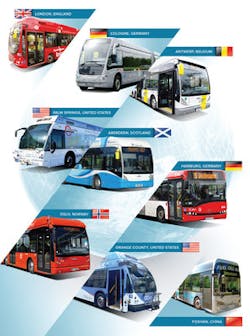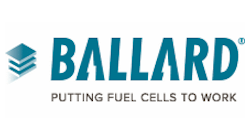Ballard is First to Power Fuel Cell Electric Buses For 10+ Million Kilometers of Revenue Service
Ballard Power Systems recently announced that it is the first fuel cell company to power buses for more than 10 million cumulative kilometers (6.2 million miles) of revenue service, equivalent to circling the Earth 250 times at the equator.
This fuel cell industry milestone has been achieved across the company's seven generations of its FCveloCity fuel cell engine, which have been deployed in buses in 15 countries on 5 continents during the past 10 years. Over this period Ballard has worked with 13 bus manufacturers to develop a variety of fuel cell bus configurations that have been deployed in a wide range of climatic conditions and operated under a host of demanding duty cycles.
Today Ballard FCveloCity engines are powering more than 80 buses around the globe: 41 in Europe, including Belgium, Germany, Italy, the Netherlands, Norway, Scotland and the U.K.; 24 in the Cities of Foshan and Yunfu, China; 13 in the U.S.A., including the states of California, Massachusetts, Michigan and Ohio; 3 in Brazil; and 1 in India.
Ballard is seeing increased market demand for FCveloCity fuel cell engines of various sizes for use in a number of different vehicle types, including:
Ongoing shipments to fulfill additional requirements of partner Guangdong Synergy Hydrogen Power Technology Co., Ltd. for more than 300 buses in Foshan and Yunfu, China; Fuel cell orders from strategic partner Zhongshan Broad-Ocean Motor Co. Ltd. to power 10,000 commercial vehicles that will be deployed in its China vehicle leasing business, thereby creating significant demand pull-through for Ballard technology; Ballard's ongoing development programs for 200 kilowatt (kW) engines to power urban light rail vehicles for China's CRRC Corporation Ltd. A recent purchase order from OEM Solaris Bus & Coach for engines to power buses for deployment in Riga, Latvia; Bidding for more than 100 fuel cell buses under Europe's Horizon 2020 funded program; and Bidding on fuel cell bus programs funded by the U.S. Federal Transit Administration (FTA) under the Low and No Emission (LoNo) Vehicle Deployment Program."The achievement of 10 million cumulative kilometers of revenue service is a major industry and corporate milestone," said Randy MacEwen, Ballard's president CEO. "We are moving beyond technical validation into commercial scaling at a time where market demand is at a breakthrough inflection point. The cumulative learning by Ballard during our unparalleled field experience serves as a major competitive differentiator."
Dr. Kevin Colbow, Ballard's vice president – technology and product development added, "We are extremely pleased with the evolution of our fuel cell engine development work and with the widespread implementation of demonstration programs around the globe over the past 10 years. Ballard has reduced fuel cell engine product cost by 75% over this period and we have improved engine reliability, durability and performance of our plug-and-play solutions to a highly competitive level. We are strongly positioned for rapid growth in scaled commercial revenue service deployments now underway and planned in China, Europe and the United States."
In the past year FCveloCity-MD 30kW and FCveloCity-HD 60kW product extensions have been added to Ballard's FCveloCity-HD 85kW product in order to broaden the addressable range of motive applications, from smaller commercial vehicles and 8 meter (24 foot) buses up to large articulated buses. In addition, the FCveloCity-XD 200kW product will be capable of powering light rail systems.
Fuel cell buses manufactured and integrated by Ballard's leading partners and equipped with Ballard engines typically offer a host of important attributes, including:
350 kilometer (220 mile) range between refuelings; Rapid refueling in as little as 7 minutes; Improved fuel economy compared to diesel buses (1.5x) and CNG buses (more than 2x); Operating performance comparable to diesel and CNG buses; Comparable durability, with several fuel cell buses having passed the 20,000 operating hour threshold; Route flexibility, with no need for en-route recharging, such as overhead catenary wiring; and Reduced noise and smoother ride for improved passenger riding experience.



